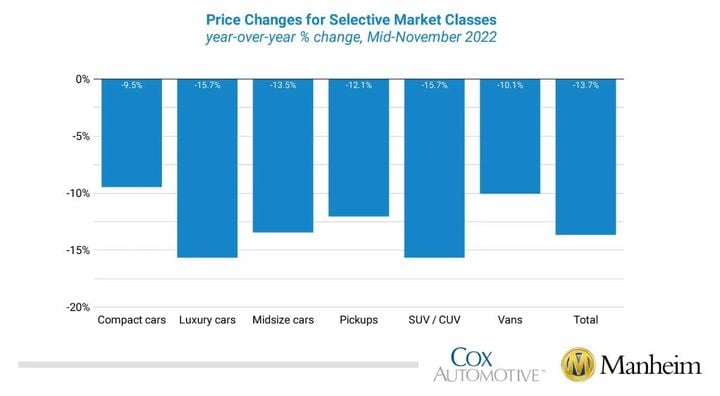
Maintaining the trend from October, all eight major market segments saw seasonally adjusted prices that were lower year over year in the first half of November.
Graphic: Cox Automotive
Wholesale used-vehicle prices (on a mix-, mileage-, and seasonally adjusted basis) increased 0.4% from October in the first 15 days of November, according to the mid-month Manheim Used Vehicle Value Index released Nov. 17, which rose to 200.7.
That was down 13.7% from November 2021. The non-adjusted price change in the first half of November declined 0.8% compared to October, moving the unadjusted average price down 11.7% year over year.
Over the last two weeks, Manheim Market Report (MMR) prices saw fairly normal declines for the time of year, resulting in a 1.1% cumulative decline in the Three-Year-Old MMR Index, which represents the largest model-year cohort at auction. During the first 15 days of November, MMR Retention, which is the average difference in price relative to current MMR, averaged 98.4%, which indicates that valuation models are ahead of market prices.
The average daily sales conversion rate of 50.7% in the first half of November declined relative to October’s daily average of 51.3%. Still, conversion rates typically decline in November, and the conversion rate was similar to the daily average in November 2019. The latest trends in key indicators suggest wholesale used-vehicle values should decline in line with normal trends in the second half of November.
Maintaining the trend from October, all eight major market segments saw seasonally adjusted prices that were lower year over year in the first half of November. Compact cars had the lowest decline at -9.5%, while sports cars, vans, pickups and midsize cars lost less compared to the overall industry in seasonally adjusted year-over-year changes. Compared to October, five major segments saw price increases, with full-size, luxury and midsize cars lower than the industry. Only sports cars and vans showed unadjusted price increases versus October.
Retail and Wholesale Days’ Supply Normal in Mid-November
Using estimates based on vAuto data as of Nov. 14, used retail days’ supply was 49 days, which was down two days from the end of October. Days’ supply was up seven days year over year but even with the same week in 2019. Leveraging Manheim sales and inventory data, Cox estimates that wholesale supply will end November at 28 days, unchanged from the end of October but up eight days year over year. As of Nov. 15, wholesale supply was at 28 days, unchanged from the end of October but up seven days yersus year over year and one day lower than at the same time in 2019. Used supply measured in days’ supply and compared to 2019 suggests supply is normal for this time of year, which indicates that depreciation should be normal for the time of year as well.
Rental Risk Prices Mixed, Mileage Down in First Two Weeks of November
The average price for rental risk units sold at auction in the first 15 days of November was up 1.5% year over year. Rental risk prices were down 0.3% compared to the full month of October. Average mileage for rental risk units in the first half of October (at 55,400 miles) was down 26.8% compared to a year ago and down 2.9% month over month.
Consumer Sentiment Measures Mixed to Start November
The initial October reading on Consumer Sentiment from the University of Michigan declined 8.7% to 54.7 as views of current conditions fell even more, and future expectations also declined. Expected inflation rates increased slightly. Consumers’ views of buying conditions for vehicles declined but was still the second-best reading since March. June was the all-time low in the reading. The daily index of consumer sentiment from Morning Consult reflects that sentiment is trending higher to start the month. The timelier measure indicated consumer sentiment was up 2.3% in the first 15 days of November. This lower measure coincided with declining gas prices in early November, an improving stock market and a relatively calm mid-term election.
Originally posted on Vehicle Remarketing
